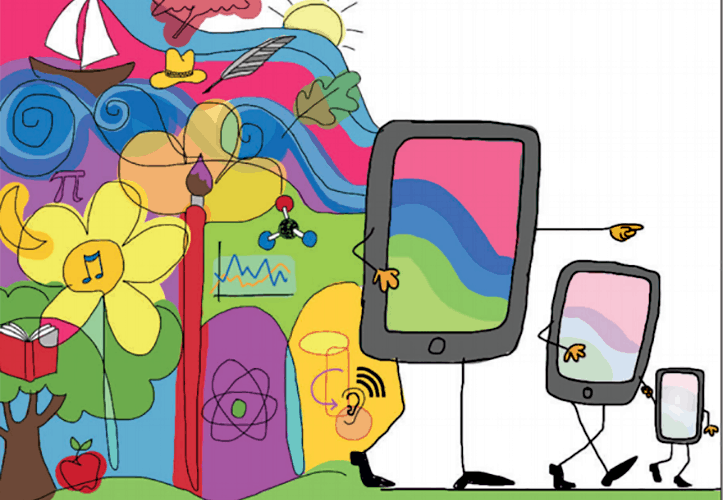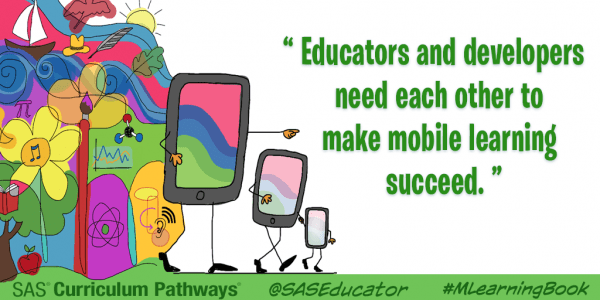Pedagogy Should Always Precede Technology: SAS Curriculum Pathways Mobile Learning

Full disclaimer: I am a teacher, and I want to keep my job. When people talk about programs to replace face-to-face teaching and learning experiences (my classroom!), I start to squirm. I started Mobile Learning, a book written collaboratively by SAS Curriculum Pathways, with a healthy dose of skepticism; however, I was soon won over because there is a respectful balance between the promotion of mobile learning and the necessity for sound pedagogy.
In fact, even as they discuss the incomprehensible 1 million apps available on Apple’s app store, they also warn that just because “there’s an app for that,” doesn’t mean that young learners are equipped to make educational decisions alone. In fact, they admonish, “…while the proliferation of apps might tempt one to scour the app store in search of the perfect app, pedagogy should always precede technology or, in this case, pedagogy should always be the primary consideration, rather than focusing only of the content of the app.” Clearly, it didn’t take me long to start trusting the authors. It was on page 59, just in case you’re curious.
It seems every institution, be it a middle school, or a university, includes the phrase, “lifelong learner” in their vision statement or motto. What everyone is getting at, I think, is the collective wish of educators to ignite a spark that can’t be put out. The authors though, suggest a 2.0 version of this wish, one that meets the needs of digital natives: they believe that mobile learning blurs the lines between formal and informal learning, in essence, facilitating the journey of the lifelong learner. Just as a master teacher is the channel for discovery, mobile devices are a portable conduit for all-the-time learning.
However, educators who wish to create a mobile classroom must recognize and extinguish desires to integrate technology piecemeal and without thoughtful consideration. The authors advise, that “successful integrations of mobile devices does not mean retrofitting existing lessons but, instead, redefining them in terms of student participation and scope.” Mobile Learning is the manual for this important evolution in education. At the core, the book tackles the underlying hotbed political question in education: are schools preparing students for the real world? The authors contend that the answer is that most schools don’t, but are optimistic that schools can.
The authors spend most of the book providing an inside look into the mobile and app world that most readers will find both interesting and mind-boggling. Until I read this book, I considered myself pretty current. Now, I know that unless you make a very concerted and concentrated effort, you won’t be current–there’s so much happening, so fast, that knowing the fundamental attributes is really important. The “Mobile Technology’s Defining Features” was by far the most useful chapter. If you’ve ever felt like a dinosaur because a kid who was born the same year you graduated college is throwing words at you like weapons of superiority, than this chapter will be very enlightening. It isn’t that you haven’t heard of 3G Connectivity, operating systems, The Cloud, or Push Notifications, but after reading this book, you’ll know enough to have a conversation instead of standing there nodding, trying not to give away that you don’t speak the the language like a native.
The book also made me want to pursue a new career in educational app development. As an educator, I was fascinated by the complexity of this process and intrigued by the layers of analysis that occurs to ensure the best app with the most user-friendly experience. As an English teacher, I loved reading about what the authors call “User Interface Metaphors.” For example, the outline of a house is easy enough for readers to relate to, indicating a move back to the home screen. However, developers must truly know and understand their audiences in order to create icons or interface options that make sense and are familiar to their users. Learning about these design elements has piqued my interest in apps, as choosing appropriate apps is now a more thoughtful process because I am now well-informed.
It is a testament to the authors’ sound writing that I found entire chapters that aren’t directly applicable to my life, “Apps for Preschoolers” for example, to be very interesting and engaging. The authors have a wonderful voice for informing the reader, but continually deferring to us as well. Instead of a list of directives or an implied conceit, it is with a nod to the the reader that the authors’ explain, “It’s incumbent on parents to determine the value of these technologies for children. Passback or hold back? Should we treat mobile apps as junk food or nutritious vegetables?” Although the authors surely have their own opinions, it never feels condescending, but rather the new information empowers consumers.
The last time a book made me feel both newly informed and entirely inadequate (but in a good way!), was Thomas Friedman’s The World is Flat. When systems are broken down, industries illuminated, and a new way of looking at human relationships is introduced, it is to be expected that the ground doesn’t seem as solid. However, having read the book, I feel prepared that if I need to know more or learn more, I’ll know where to turn–to the staggeringly complex, yet enticingly approachable world of mobile learning.

For more blogs by Amber Chandler, check out:



0 Comments
Leave a Comment
Your email address will not be published. All fields are required.